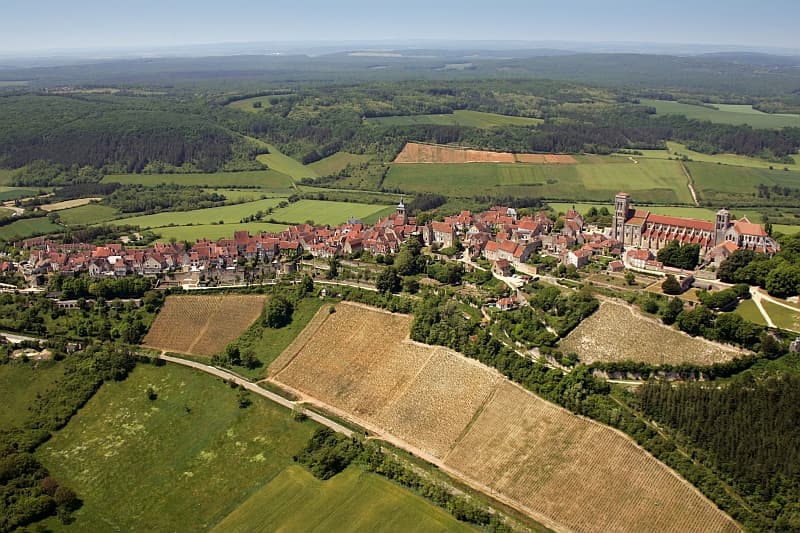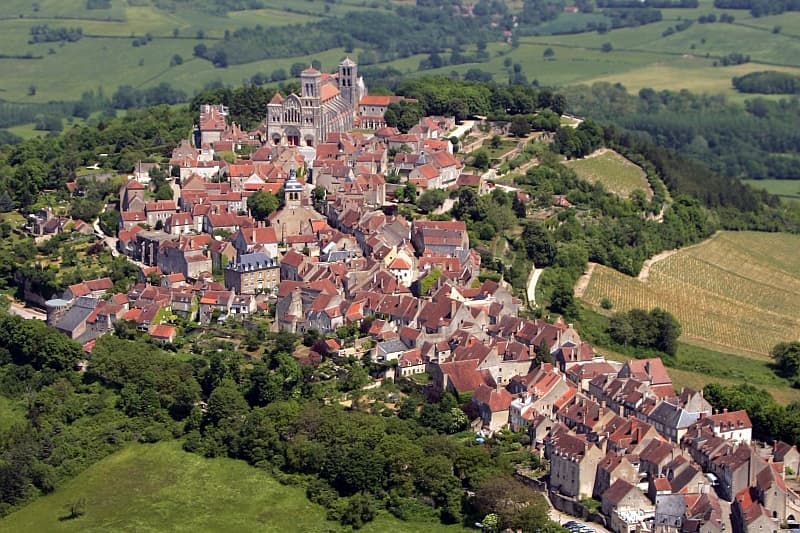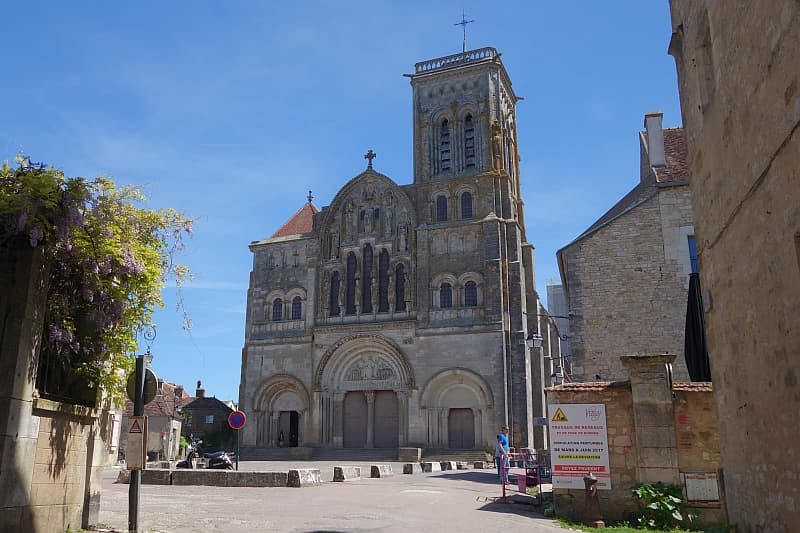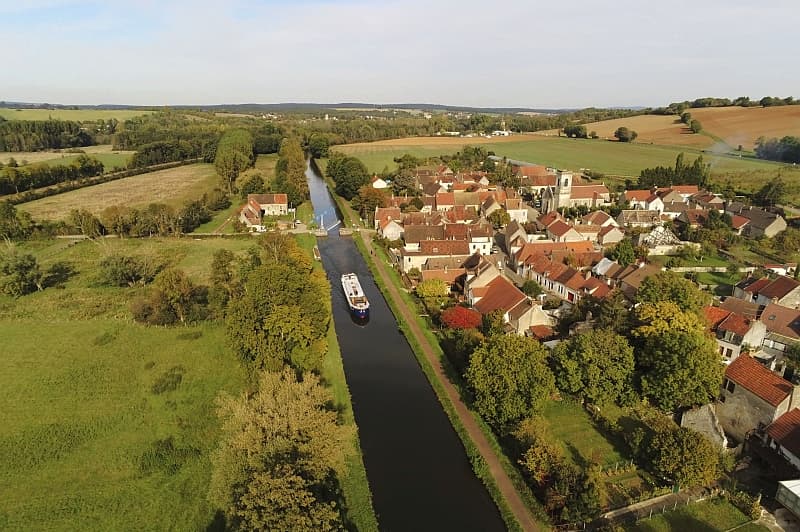Vézelay has been described as one of the most beautiful villages in France. Placed fifty kilometres south of Auxerre, it is situated in the region of Burgundy. The town of Vézelay is centred around the Church of St Mary Magdalene and inhabits a hill that offers stunning vistas of untouched French countryside. Bordering Morvan Regional Park, Vézelay offers a romantic, untainted experience of France and preserves a wealth of culture, tradition, and history.
The Historic Town of Vézelay in Burgundy

The Benedictine Abbey of Vézelay
Vézelay owes its existence to the Benedictine Abbey of Vézelay, which is said to have entombed the remains of Mary Magdalene. Built under the instruction of Gerard, Duke of Burgundy, the Church of Mary Magdalene transcends the top of a hill known as the ‘eternal hill’. Originally constructed in 771, the abbey was founded to protect the holy relics, which were reputedly rescued from a Muslim invasion of Ephesus, in modern day Turkey.
According to the narrative, the burial remained secret and even the monks themselves did not know about the concealment of Mary Magdalene’s skeleton. In around 1050, the monks rediscovered Mary Magdalene’s remains, and word spread throughout France that she was buried at Vézelay. The location quickly became a place of Christian pilgrimage, as Vézelay was a convenient place to stop on the road to the Church of St James at Santiago de Compostella, a popular pilgrimage site in Spain.
Mary Magdalene’s remains were not officially recognised as belonging to her until 1267, when the King of France, Louis IX, examined them himself and proclaimed that they belonged to the Saint. However, later in the century, Saint-Maximin-la-Sainte-Baume laid claim to having Mary Magdalene’s body, and Charles II of France confirmed the claim. As a result, eventually Vézelay fell out of favour with pilgrims.

The Church of Saint Mary Magdalene in Vézelay
The current Madeleine of Vézelay was built in the 12th century and the monastic church is all that remains of the Benedictine abbey. Filled with Romanesque art and architecture, the Church of St Mary Magdalene gives an insight into religion in the 1200s. Filled with high vaulted ceilings, semi-circular arches, and imposing pillars, it’s a fantastic example of the Romanesque style of architecture that was popular around the 12th century.
One of Vézelay Church’s most famous artistic features is the frieze of the Mission of the Apostles, which is carved into the tympanum above the interior portal doors. The Mission to the Apostles dates from 1120-32 and is a unique example of Romanesque architecture. Centred around Christ, the scene shows Jesus blessing the apostles and telling them to convert the nations. Each of the saints holds a gospel, which is representative of their mission. They are surrounded by medieval interpretations of people from outside the West. Based on stories from the First Crusade, some of the figures have huge ears and others are shown using ladders to climb their horses!
Revolutionaries destroyed Vézelay abbey in the late eighteenth century and only the Church of the Madeline remained. Having succumbed to heavy damage, it was restored in the 1840s and part of its vaults were rebuilt under the direction of Eugène Viollet-le-Duc. UNESCO designated the entire village of Vézelay a world heritage site in 1979, due to its historical significance. The whole area surrounding Vézelay church, including the landscape, is protected from any further development.
Guests to the church will find it to be a place of reflection, peace, and calm. Time seems to stand still as you admire the striped vaulted ceilings that soar above your head, making you feel small and insignificant in the presence of a Christian God. This historic spiritual centre still inspires so much of the awe and mystique it did when it was first built in the 1100s.

Vézelay and the Crusades
The Church of Vézelay is intertwined with the history of the early part of the Christian crusades. The wars between Christian and Islamic armies defined the first part of the second century and numerous calls to arms were made by the Catholic Church from 1095 to around the 1500s.
Vézelay is most closely linked with the Second and Third Crusades. In 1144, the Muslim ruler of Aleppo and Mosul captured Edessa, which was formerly a part of the ancient Greek territory of Mesopotamia. Pope Eugenius II was enraged, since Edessa had been Christian since 325, so in 1145 he issued an appeal for support from Christian rulers. In 1146, St Bernard preached the Second Crusade at Vézelay, resulting in Louis VII and the Frankish armies uniting to go to war.
The Second Crusade lasted until 1149, though the expedition to the Holy Land was characterised as a complete disaster. In 1148, the armies of Louis VII and Conrad III of Germany attacked Damascus, the most important city in Syria. Due to a lack of resources, supplies and finances, Christian forces were forced to retreat after only four days, resulting in defeat for the Catholic armies.
The bitter sting of failure for Christians meant that Western troops would not reassemble against Muslims for the best part of another one hundred years. However, after Jerusalem was recaptured under Saladin, the Egyptian and Syrian ruler, the call for a Third Crusade was successful. At Vézelay in 1190, the English King, Richard the Lion-heart, and French King, Philip II, met to leave for the third crusade. Widely recognised as a success under the leadership of King Richard, Christian forces successfully negotiated a treaty with Saladin allowing unarmed pilgrims and merchants to pass through Jersualem unencumbered.

The Village of Vézelay
The 12th century village of Vézelay owes its existence to the abbey and church of St Mary Magdalene. Consisting of one long street that climbs the hill to Vézelay church at the top, the historic town encircles the ‘eternal hill’. Entering through the two towers of Porte Neuve, visitors enter onto historic streets lined with medieval buildings and the remains of ramparts.
The vibrant village is filled with cafes, galleries and gift shops. The quiet, cobbled streets are scattered with shells that were laid there by pilgrims setting off to walk from Vézelay, in France, to the church of St James at Santiago de Compostella, in Spain. On reaching the top of Vézelay, experience extraordinary views of the surrounding landscape, which features picturesque Burgundian vineyards, meadows, and forests.
Situated on the north side of Vézelay is the Church of the Holy Cross. Built in 1217 under the instruction of Francis of Assisi, Vézelay was chosen as the first French Franciscan establishment. The location of Vézelay was chosen because it was the place the Second Crusade was preached. As Francis was against the crusades, it is likely that he hoped to set brothers to work converting people to Christianity in a non-violent way.
Visit Vézelay aboard L’Art de Vivre
Cruise aboard L’Art de Vivre to enjoy your very own modern-day pilgrimage to Vézelay. Explore the town at leisure after lunch aboard out hotel barge, which moors at nearby Lucy-sur-Yonne. For more information on our cruises in Bordeaux, and the rest of our collection of luxury hotel barge cruises, why not order a free copy of our brochure or speak to a member of our team directly using our handy Contact Form.

 English
English
 Spanish
Spanish French
French German
German Norwegian
Norwegian Portuguese
Portuguese Swedish
Swedish Italian
Italian Russian
Russian Simplified Chinese
Simplified Chinese Japanese
Japanese